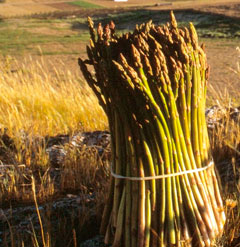Espárrago de Huétor-Tájar
Espárrago de Huétor-Tájar is an IGP Spanish asparagus.

Description:
Asparagus grown from green-purple, tender, healthy and clean shoots obtained from seedbeds of native asparagus, a tetraploid subspecies of Asparagus officinalis.
Characteristics:
-shape: slender asparagus, with a stem measuring 4 to 12 mm in diameter. Pointed tip with a diameter larger than the rest of the stem. The shoot is purple-bronze, purple, bronze, green-purple or green in colour
-organoleptic: tender, fleshy and firm texture, delicate sweet-sour flavour and a deep aroma
-cytological: tetraploid chromosomes (2nØ=Ø40)
Classes protected: Extra and Classe One
Size: (a)according to length of stems (20 to 30 cm); (b) according to diameter (between 4 and 10 mm and 10 mm and above).
May be sold fresh or preserved.
Geographical area:
Situated in the western part of the province of Granada, in the lower alluvial plain of the Genil river, between the Subbetic chain to the north and the Penibetic chain to the south. Comprises the municipalities of Huétor-Tájar, Illora, Loja, Moraleda de Zafayona, Salar and Villanueva de Mesòas. Covers a total of 78,000 ha.
Proof of origin:
The seeds and seedlings are produced and selected by local farmers, in seedbeds registered with, and under the control of, the regulatory body and are kept in nurseries situated in the production area. The propagating material is produced under the control of the regulatory body. The asparagus fields are located in the production area and entered in a special register. Cultivation techniques, harvesting and transport to the packing stations are all under the control of the regulatory body, the latter also being responsible for supervising the packaging of fresh asparagus and the processing of processed asparagus.
Method of production:
After being selected by registered stations, shoots of native asparagus plants are packed in the fresh state in homogeneous bundles of 0,5, 1 or 2 kg and placed in suitable crates for transportation.
When asparagus is intended for sale as a preserved product the shoots undergo an industrial process whereby: the stems are washed, cut according to the size of the container (about half-way up), cooked, cleaned, graded, and placed in containers; liquid is added, the containers are preheated and sealed, sterilised, refrigerated, etc.
The entire process is under the control of the regulatory body.
Link:
Asparagus was first cultivated by the Ancient Romans. Green wild asparagus is mentioned as a prized ingredient in recipes compiled by the Andalusian historian Ibu Bassal in various books on Al-Andalus cooking, and survived in that region until the end of the Narzarò dynasty late in the XIVth century.
Asparagus (in essence wild asparagus) continued to be grown - for own consumption - on small family farms in the plain of the Genil river, this region being a pioneer in the cultivation of the crop, stepping up production from 1930 onwards.
A flat region with alluvial deposits and terracing where secondary and tertiary material come to the surface. Asparagus is grown at an altitude of 450 to 650 metres. The soil consists of heavy or medium or, in some cases, light loam, with a pH between 7,8 and 8,4 and a carbonate content, expressed in calcium carbonate, exceeding 40Ø%, a high potassium and magnesium content due to the dolomitic nature of the carbonates present, and low levels of assimilable phosphorus and organic matter. The high magnesium and low phosphorus content is conducive to strong pigmentation of the shoot, the stem being a deeper green and the head more purple. The high potassium content inhibits sprouting of the head. Continental Mediterranean climate with an average temperature of 16,3ØC, average annual rainfall of the order of 350 mm and light winds. The cultivation techniques, work carried out, and pest and disease control provide ideal conditions for growing asparagus with characteristics linked to its environment.
Reference: The European Commission